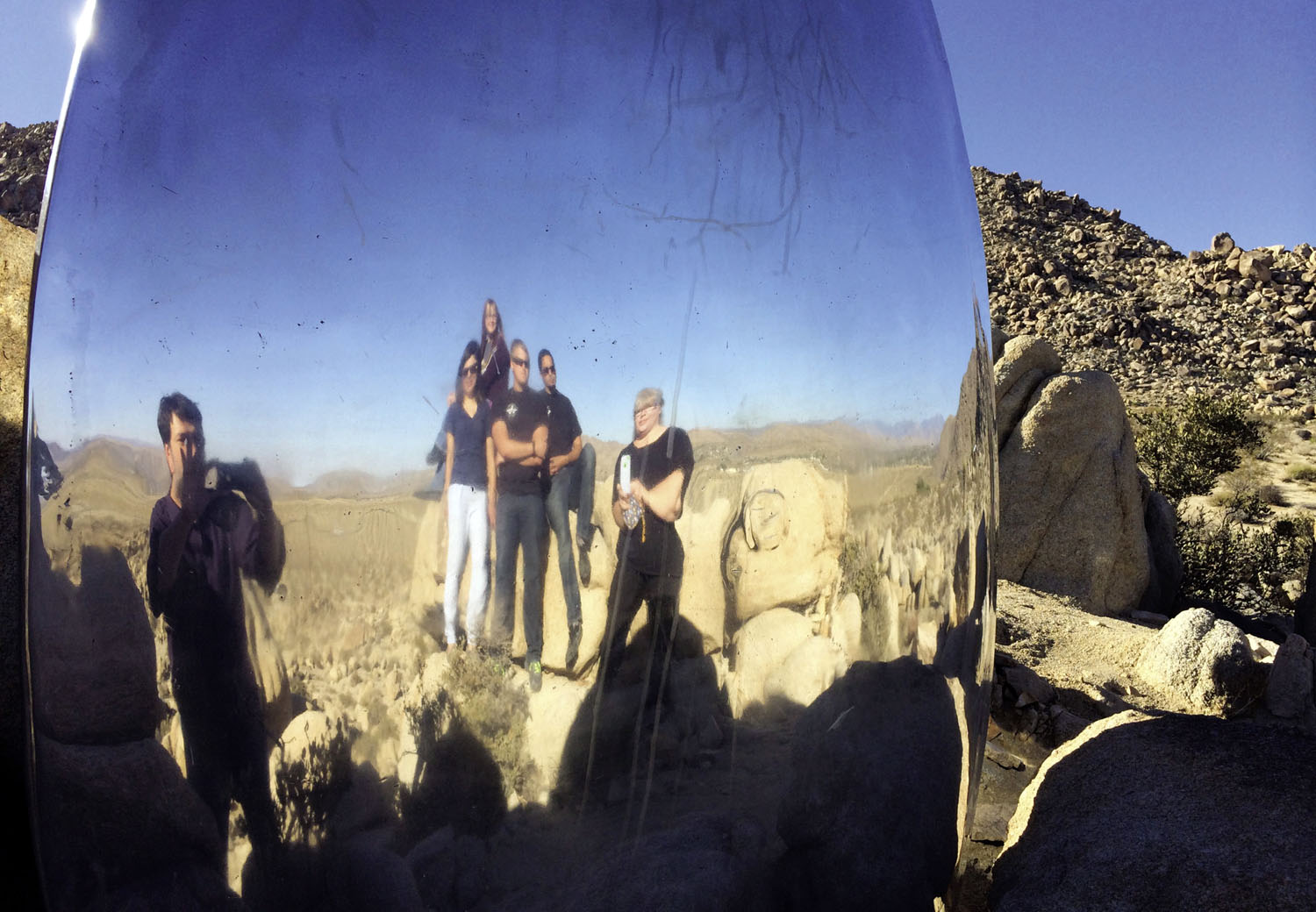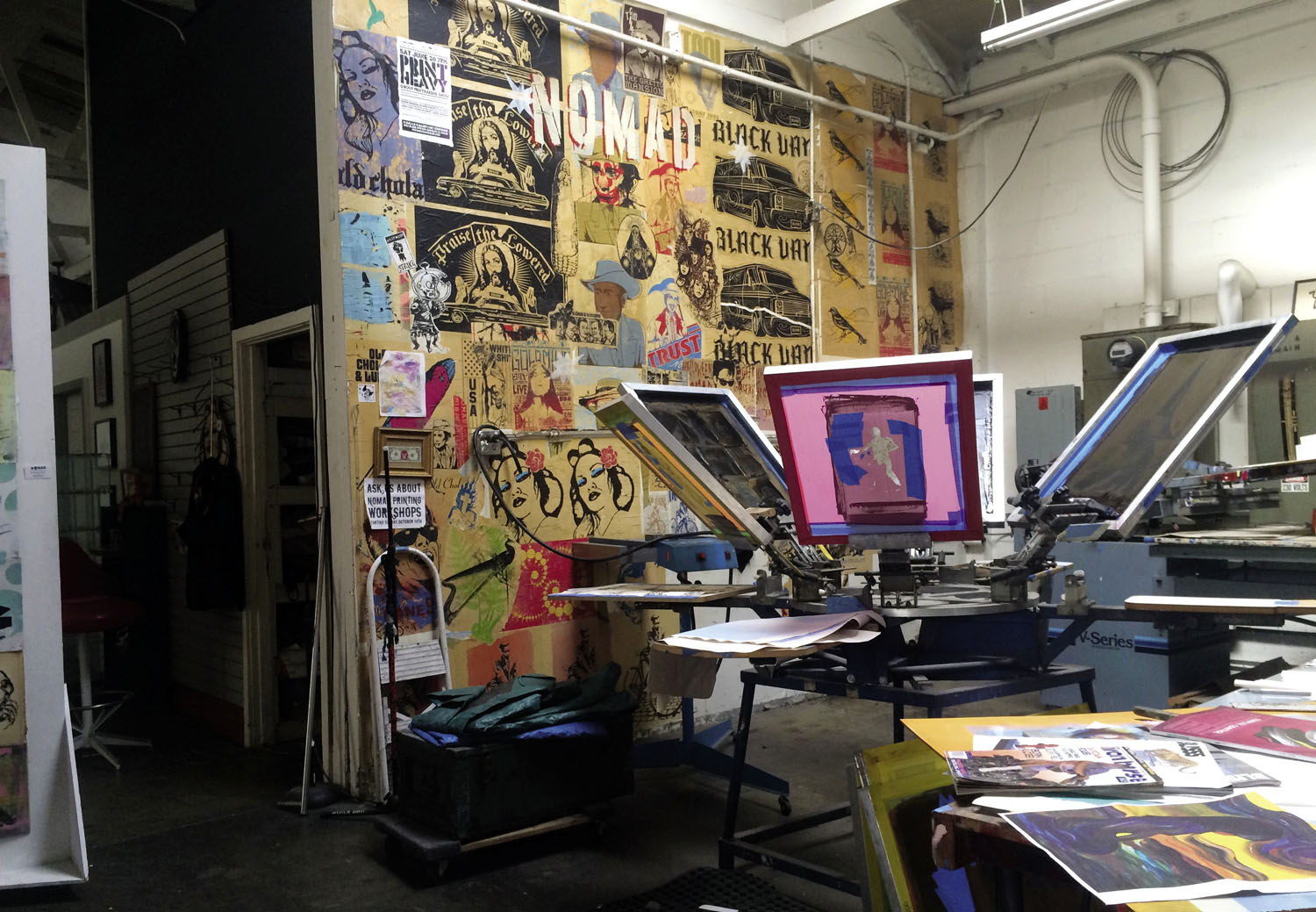
Six of Wichita State’s School of Art, Design and Creative Industries students, led by Robert Bubp, associate professor of painting and drawing, hit the road to California in October for a weeklong artist residency as part of the Professional Practices class.
This Shocker group of seven is far from the first to make the trip from Wichita to the Golden State. For inspiration, the members of this newest set of artistic travelers need have looked no further than the example of the late great Bruce Conner fs ’53, some of whose artworks have been on display at WSU’s Ulrich Museum of Art this fall in Somebody Else’s Prints.
After leaving Wichita and landing in San Francisco in 1957, Conner became an influential figure in American art and film, his nylon-shrouded assemblages capturing international acclaim, his independent films garnering instant renown in avant-garde film circles. But Conner made his trek to California and artistic fame after his University of Wichita studies; Bubp’s six WSU students are right in the middle of theirs.
“We’re working to reinvent the program here,” Bubp says. “More hands-on learning. We had another group of art students in Yokohama, Japan, at the same time we were in California.”
Bubp rented a house near the Joshua Tree National Park to serve as home base for participating Professional Practices class members: Michelle Calhoun, Rhonda Davis, Darren Jones, Landon Schmidt, Wendi Valladares and Molly Williams. “Before embarking upon the weeklong artist residency, the students, four of whom won university-based grant funding to support the trip, had already contacted an arts organization somewhere in the area — could be in LA proper — to volunteer with them for eight to 20 hours of the week. They had an artistic agenda already mapped out. We all went into the city to see museums and sites on two of the days. So we did what artists do on a residency or even when they are moving to a new place — just doing it for class credit in the middle of a semester,” Bubp explains.
He adds, “I noticed that the whole endeavor mirrors what students must do after graduation. They leave one community, the university, for another, the art community in Wichita or elsewhere. I saw their professional and personal confidence increase significantly as they made their own contacts and created their own agendas in this new place.”
For Bubp and his six Wichita State art students, this new place is a full-fledged art scene set within the scorched landscape at the foothills of the Mojave Desert in Southern California. It’s an area Bubp calls “compelling for its history of homesteading, its raw beauty, its proximity to LA — and its weirdness.”
Located just about 125 miles east of Los Angeles, the high-desert area has long been a favored destination for rock climbers who are attracted to the oddly shaped boulders at Joshua Tree National Park.
The fantastical landscape provided the art students with some of their most special memories of the trip. “Overall,” Valladares says, “the most memorable experience was finding a quiet spot in the Joshua Tree National Park amongst the thousands of boulders and looking up at the vast sky to see the luscious pink sunset behind the line of mountains.
I felt completely lost in the landscape, and I loved it.”
Schmidt adds, “My favorite experience was the surreal aspect of the encounter towards the landscape outside of Joshua Tree.”
“Joshua Tree was simply amazing,” Davis reports, “The rock formations and the Joshua Trees take on human forms. This was particularly interesting to me since I use the human form and natural forms in my work.” Davis has already applied for and received a creative research grant from WSU’s Honors program to create a body of work based on experiences gained and sights seen during the trip to California.
About the area, Jones says, “Since I am originally from about three hours north of Joshua Tree, it was nice being back in a familiar climate and environment. The days spent painting in the desert were vaguely reminiscent of time spent in the foothills as a kid.”
Among the boulders, Joshua Trees, cacti, creosote bushes and abandoned homesteader cabins, many of which date back to the government’s 1938 attempt to populate the barren federal lands by offering a free five-acre parcel to anyone willing to put up a structure — set out among these high-desert landmarks — are striking artworks by contemporary artists, including Andrea Zittel, Jason Rhoades, Sarah Vanderlip and Jack Pierson, as well as artists’ studios set up in almost every kind of structure imaginable: old ranch houses, shipping containers, even geodesic domes left over from the 1970s.
This past October, the denizens of the desert were joined by artworks created by Jones, whose artist-residency project centered on making artifacts — “creating evidence,” as he puts it — of a fictitious culture complete with its own written language, a culture, he says, that exists outside of but is contemporary with mainstream culture.
“This ‘other’ culture utilizes a different language that, although difficult to translate, is ultimately decipherable by the average passers-by, if they take the time,” says Jones, who painted structures and distributed stickers with messages from his ‘other’ culture around the rural desert area.
In Los Angeles, he presented works from his art project to printmaking students at the University of Southern California.
“In my work,” Valladares says, “I am interested in the personal and cultural relationships we create daily and why we invest in the ones we do. Visiting Joshua Tree gave me the opportunity to observe the rich, diverse community, especially the Hispanic community I grew up in.”
For her artist-residency volunteer service, Valladares assisted Self Help Graphics & Art, a community arts center in east LA, with one of its many public workshops, this one in support of a Dia de los Muertos celebration, an annual cultural event sponsored by the art center.
She says, “During my visit, I came to see my love for people and the arts even more clearly. For SHG&A to freely and generously allow me to come alongside them and for the new random friends I made during this trip, I had a confirmation that this is what I was meant to be doing — art. Art brings people together, and that is what I’m after.”
For her artist residency volunteer service project, art brought WSU student Williams together with Jennifer Grace, the outreach coordinator at the American Museum of Ceramic Art in Pomona, Calif. “We did outreach work with senior citizens in San Bernardino,” Williams says, “and I helped Jennifer glaze and fire pieces at the museum studio. I learned more about various museum careers and potential opportunities within my field.”
Both Davis and Schmidt made contact with Damon Robinson, an artist, musician and founder of the Nomad Art Compound in Los Angeles, an art lab designed to be a studio, an event and exhibition space, as well as the home to Robinson’s art and apparel lines Praise the Lowered and the Black Van.
“While Landon and I were there,” Davis says, “Damon talked quite a bit about how he started Nomad and how he runs a successful business on many levels. It was an excellent learning experience. He talked a lot about putting together a portfolio and the logistics of getting work done. We spent two days there, and honestly he freely offered so much good information that I wish I had recorded it. He also let us make a set of silkscreen prints from designs that we had drawn the night before. I learned a lot about the business of getting a studio together, the importance of diversifying your product line and offerings, and also some alternate materials and ways of working that I plan to incorporate into my current studio practice.”
Schmidt, too, gleaned from Robinson some insider knowledge about a variety of technical skills and studio practices. “Damon displayed different ways to approach art practices and useful ways of selling artwork to the public,” Schmidt says.
For WSU art student Calhoun, BoxoPROJECTS was the source of her artist-residency volunteer experiences. With its tag line “Contemporary Art at the New Frontier,” BoxoPROJECTS supports emerging and midcareer artists by fostering their work and helping them gain a wider audience for it. BoxoPROJECTS has two main operations, BoxoOFFICE, based out of New York City, and BoxoHOUSE, in Joshua Tree. BoxoHOUSE serves as a research outpost for artists to investigate ideas about “place, community and the environment.”
Back at Wichita State, Bubp’s six artist-residency students are again engaged in their university studies and pursuing their individual creative industries — each of them richer in some way from their trek to California. “All of them did or saw something that expanded their horizons,” Bubp says. “I think they’ll agree about that.”
They do.
“Artistically, this trip has been extremely important to me,” says Davis, who plans to apply for an artist residency based either in the Joshua Tree or the LA area in 2015. “I was exposed to many works and methods of producing work that I had never imagined. I seriously doubt I would have ever gone to California on my own. I realized I can do what I thought was going to be overwhelming. This trip forced me out of my comfort zone and made me realize that I was holding myself back from learning experiences based on false fears.
“It was a good lesson.”






